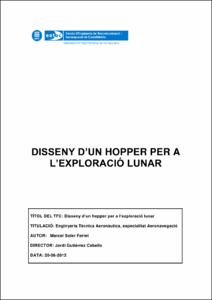Mostra el registre d'ítem simple
Disseny d'un hopper per exploració lunar
| dc.contributor | Gutiérrez Cabello, Jordi |
| dc.contributor.author | Soler Ferret, Marcel |
| dc.contributor.other | Universitat Politècnica de Catalunya. Departament de Física Aplicada |
| dc.date.accessioned | 2012-07-05T11:39:31Z |
| dc.date.available | 2012-07-05T11:39:31Z |
| dc.date.issued | 2012-07-03 |
| dc.identifier.uri | http://hdl.handle.net/2099.1/15550 |
| dc.description.abstract | The Moon despite of being so close, speaking in terms of typical space scales, is a rather unexplored place, and it may still hide a lot of surprises. It can be very useful if we use it as a launch base because her gravity is six times lower than Earth's, thus allowing a huge energy earning, with the concomitant reduction in the size of the rockets. The objective of this thesis is to design a space rover for the exploration of the Moon with a size equal or lower than 100x100x100 mm, which does not have wheels, and with a weight lower than 1 kg. All the systems will be theoretically designed first; when the design proves successful from the theoretical point of view, a working engineering model will be created to actually test that the system operates correctly. To design all the systems we have followed the approach given in the book Space Mission Analysis and Design (Wertz, Larson, 1999). Once the system is theoretically viable, the system has been implemented and tested to show that it fulfils our expectations and requirements. The systems we have built do not have to be exactly like the theoretical designed ones, but only an engineering model to prove that the principle in which it is based is valid. All the systems will be controlled by the control system with one computer or mobile device connected through Bluetooth. Finally, all the systems have been drawn accurately in 3D with real dimensions and with the right materials from which we expect to make the actual system; we have also checked with this 3D model that the mobile systems could move properly and without problems or undesired interactions. After that, we have extracted all the physical properties of the robot and verified whether the theoretical study was right. |
| dc.description.abstract | La Lluna tot i tenir-la tant a prop continua essent en gran mesura territori desconegut, i és molt probable que futures exploracions donin lloc a sorpreses considerables. Té molt d’interès com a futura base espacial i sobretot com a punt de llançament cap a la resta de l’espai, ja que la seva gravetat, molt més baixa que la de la Terra, suposa un estalvi energètic molt gran i permetria reduir la mida dels coets. L’objectiu d’aquest treball és dissenyar un rover per a l’exploració lunar de 100x100x100mm que no tingui rodes i que pesi menys de 1 kg. Es dissenyaran cadascun dels sistemes, es demostrarà teòricament que siguin vàlids. S’ha seguit el mètode explicat en el llibre Space Mission Analysis and Design (Wertz, Larson, 1999) per començar a idear els sistemes. Un cop assolit un disseny apropiat, s’han muntat per separat i s’ha provat que la idea fos corrrecta. Els sistemes muntats no són exactament com els que s’han dissenyat, sinó un model d’enginyeria per comprovar que la idea sigui vàlida. Els sistemes s’han enllaçat amb el sistema de control mitjançant un ordinador o un telèfon mòbil a través del bluetooth, el que permet comprovar el funcionament de tots els sistemes. Per finalitzar, tots els sistemes s’han dibuixat en tres dimensions i a escala, tot precisant el material de cadascun, i s’han muntat de manera que es pogués veure el moviment de les parts mòbils per tal de comprovar que no hi hagués cap sistema que ocupes espai dels altres, impedint així que es poguessin moure en llibertat. Un cop s’ha obtingut un disseny versemblant s’han extret les propietats físiques de robot a escala real i s’ha comprovat que l’estudi teòric fos consistent amb aquelles propietats. |
| dc.language.iso | cat |
| dc.publisher | Universitat Politècnica de Catalunya |
| dc.rights | Attribution-NonCommercial-ShareAlike 3.0 Spain |
| dc.rights.uri | http://creativecommons.org/licenses/by-nc-sa/3.0/es/ |
| dc.subject | Àrees temàtiques de la UPC::Aeronàutica i espai |
| dc.subject.lcsh | Outer space--Exploration |
| dc.subject.lcsh | Moon--Exploration |
| dc.subject.other | Exploració lunar |
| dc.subject.other | Robot |
| dc.subject.other | Hopper |
| dc.title | Disseny d'un hopper per exploració lunar |
| dc.type | Bachelor thesis |
| dc.subject.lemac | Exploracions espacials |
| dc.subject.lemac | Lluna -- Exploració |
| dc.rights.access | Open Access |
| dc.date.updated | 2012-07-05T06:13:00Z |
| dc.audience.educationlevel | Estudis de primer/segon cicle |
| dc.audience.mediator | Escola d'Enginyeria de Telecomunicació i Aeroespacial de Castelldefels |
| dc.audience.degree | ENGINYERIA TÈCNICA D'AERONÀUTICA, ESPECIALITAT EN AERONAVEGACIÓ (Pla 2003) |


